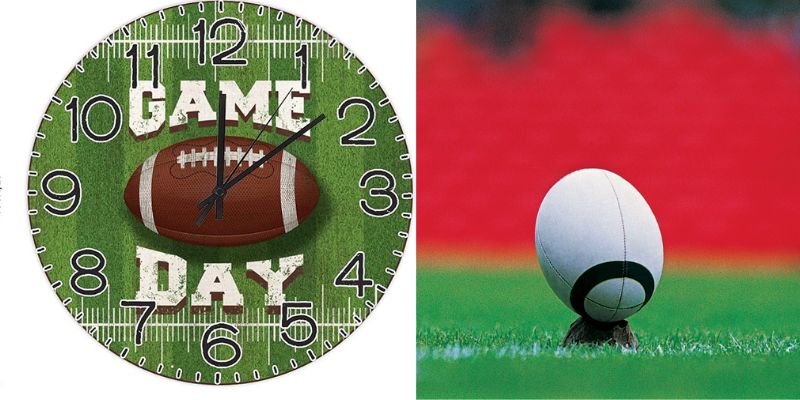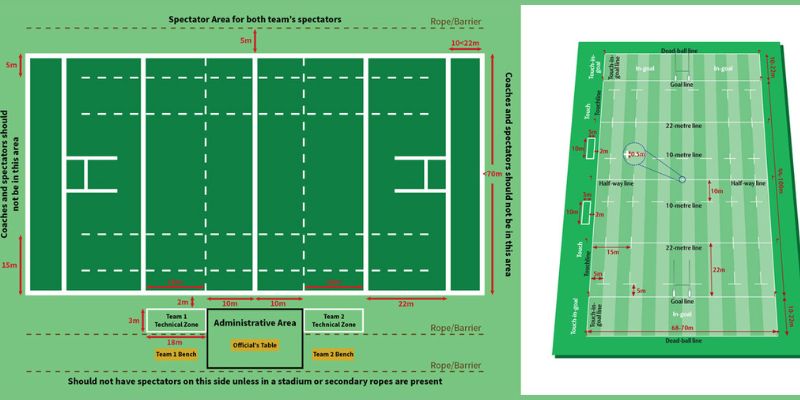Rugby is one of the most popular games with more than 2.3 million registered players and played in more than 100 countries. Like football or basketball, rugby has its own rugby rules and regulations that govern how players conduct themselves on the field and interesting rugby history.
How many players are in the rugby teams?
Each rugby team must have 15 players with no more than 7 substitutes.
How long is a rugby game?
The duration of the game may depend on certain conditions, but in general the game lasts 2 halves of 40 minutes each.
What is the total area of the rugby pitch?
The playing fields may vary slightly in size, but should fit within the following dimensions 7,208 – 10,080 meters.
What are the basic rugby laws?
Players may not headbutt, legbutt or otherwise injure opponents.
Are there ties in rugby?
Yes, there can be draws in rugby, there are no extensions for this reason. Each team receives 2 points for a draw and also receives a bonus point depending on how they played.
Want to know the rugby rules enforced by referees on the field? Or just want to know how to play rugby for beginners? Keep reading!
Rugby Rules
The following are rugby rules that govern the game. Do you need rules of rugby for beginners? Here you are!
In a rugby game, each team starts with 15 players with up to 7 substitutes. If a player has left the field, they are only allowed to return if they’re treated for an injury.

The rugby pitch dimensions must be roughly 100 meters long and 70 metres wide with a minimum of a 10-meter ball area. The goals need to be H shaped and 6 metres wide with no restrictions on height.
In addition, the field must contain the halfway line, 22-meter line, 5-meter line, dead ball line, and 10-meter line. Also, it must have a center spot for restarting the game after a player scores a penalty, try, or drop goal.
A rugby game must have a referee and two touch judges. The referee’s job is to make decisions throughout the game, time keep and keep order on the field. The two-touch judges assist the referee with decisions or notify the referee when the players are in touch.
Rugby Laws
One of the rugby laws is that players must always stay behind the ball if one of the players plans on receiving a pass. The player with the ball must always be ahead of other teammates in relation to the opposing goal line.

Rugby is a social sport with lots of physical contact. This does not mean that all types of physical contact are acceptable. Kicking, punching, headbutting, elbowing, and kicking are not permitted and considered foul play.
Players must always respect the referee and other officials. Being disrespectful or rude to the referee will hurt you and your team.
All amateur and professional rugby leagues have drug policies that players must follow. Violating a league’s drug policy may result in severe disciplinary action not only towards the affected player but the whole team.
Duration of Rugby Game
So, how long is a rugby game? A typical rugby game is usually broken down into two 40-minute halves with a 10-minute rest period. However, this can vary with the type of rugby being played. For example, an under-13 game consists of 25 minute halves while under-15 rugby matches have two 30-minute halves.

How long is a rugby match? In a professional rugby game, the games consist of two 40-minute halves where the halves run without stoppage just like soccer.
While rugby game length take 80 minutes in total, in real-time, it take 100 to 120 minutes to complete. This is because the referee takes into account a 15-minute halftime, game stoppages, and any injury.
In rugby seven matches, the games consist of two seven-minute halves. These games are extremely quick and often allow teams to play two or three matches in a day. In real-time, sevens games take 20 minutes to complete with two-minute halftime and game stoppages included.
In rugby matches, the games do not end when the clock hits zero. Instead, the matches enter a final play scenario at the 40-minute and 80-minute marks. This scenario usually continues until a dead ball occurs.

If a restart of play from a lineout, kickoff, or scrum occurs after a score, the game ends. Most rugby games can end in a tie. This may happen when the score is een or the time runs out. However, at the knock stage in the Rugby World Cup, the two teams that tied have to play 20 more minutes.
Rugby Field Dimensions
The rugby field dimensions are, as everywhere, calculated by width and length. The length of a rugby field varies between 94 to 100 metres. If you include the in-goal areas, the length will range from 106 to 144 m. The width of a rugby field can be between 68 to 70 m. In total, the rugby field size is between 7,208 to 10,080 square meters.
The rugby field has many pitch markings which might seem complicated at first but they are straightforward to understand. The touchlines should be 94 to 100 meters long while the goal lines or try lines are between 68 to 78 metres.
A rugby field has a dead ball line which marks the end of the in-goal area at the end of the field. It should be 6 to 22 meters from the goal line. You also have the goal lines which run parallel to the dead ball line lines. They measure 68 to 78 meters across.

The dead ball line, goal lines, and pitch size are usually marked with solid white lines. In the middle of the goal lines at both ends of the field, you have the rugby goalposts. These posts are 5.6 meters apart and 3.4 meters high. The top edge of the crossbar that sits horizontally between the goal posts is 3 meters above the ground.
Rugby Scoring Rules
There are four ways of rugby scoring system.
Try
Players score a try when the ball is grounded over the opposing team’s goal line. The referee can also award a penalty try when a player scores but for foul play by the opposing team. In a normal try, the team scores 5 points while a penalty try is worth seven points.
Conversion
When scoring a try, a team can try to add two more points. They can do so by kicking the ball over the crossbar. Basically, a player can take the conversion kick as a drop kick or place kick. If successfully done, the team wins 2 points.

Drop goal
When a player scores a drop goal, they score 3 points for their team. A drop goal is where a player drops the ball to the ground and kicks it.
Penalty
The last in the rugby scoring rules, we have the penalty where a team can score 3 points. The referee can award a penalty after an infringement by the opposing team.
Conclusion
Rugby is one of the most popular sports in the world played and enjoyed by millions globally. While playing rugby is fun, the game has many rugby rules that players and even officials must follow.
Kicking, headbutting and other forms of physical contact are not accepted and the referee can penalize players. To ensure everyone enjoys the game and prevent unnecessary injuries, players must always follow the rugby rules. Hope you found this information and rugby tips useful.





